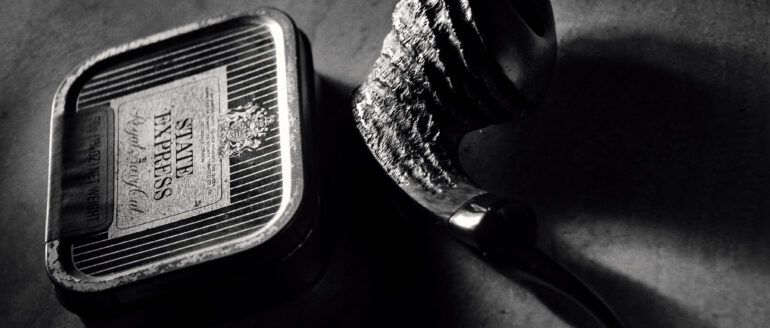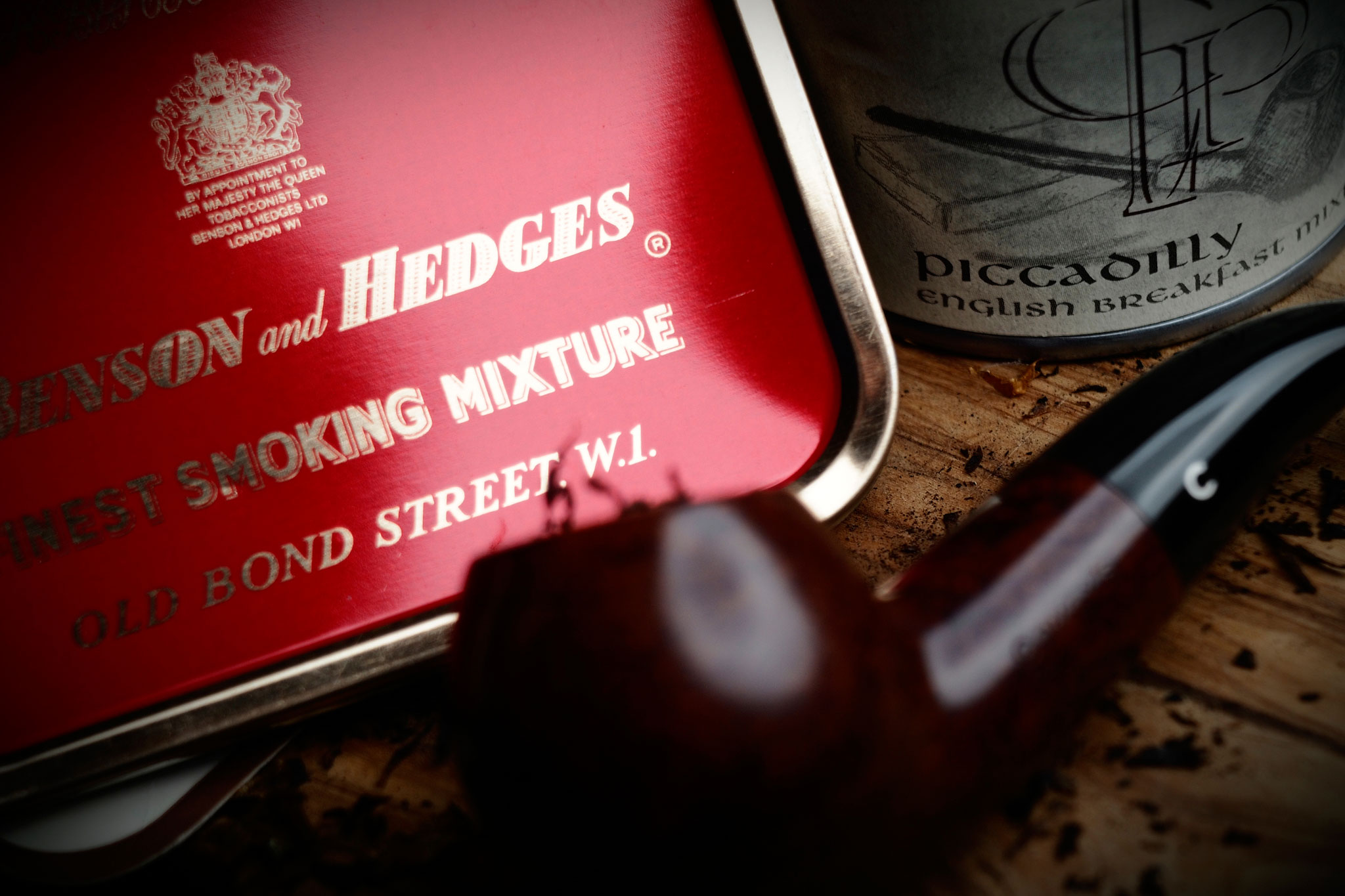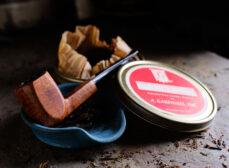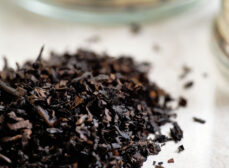
It might be hard to believe, but there was a time, not all that long ago in the timeline of pipe smoking, when people didn’t even think about aging tobacco. It was a consumable commodity – something to buy, to smoke, and to buy again. Even in the early 80s, we never thought about something going out of production, or changing formulae, or, more germane to today’s topic, benefiting from resting for many years in the tin. Then, one day, the world changed. I wandered into Drucquer & Sons, as I often did during breaks from classes, and had my mind just a little bit blown.
Robert Rex, owner of the shop at the time, was usually pretty reserved, but as I walked through the doors, I noticed he was rather animatedly talking about the tin of tobacco in his hands. Five years before, he’d put away a selection of several of the shop’s blends to experiment with the effects of aging on them. Robert was also a winemaker, and so no stranger to the idea of aging things. The tobacco we tasted that day was Red Lion, and the experience is one I’ll never forget. It was already one of my favorites in the shop’s repertoire, but those five years, the tobacco sequestered in its tin and forgotten about, had transformed it into something deeper, richer, more complex, and beautifully integrated.
I have no idea if Robert was the first tobacconist to intentionally do this, but it certainly felt like something of a revelation that day. Over the next few weeks, many of the Drucquer’s hangers-on had similar opportunities to taste the old stuff that Robert was opening, and just like that, a movement was afoot. We all started visiting tobacconists wherever we traveled, asking if they had any old stock in the back room. Sometimes, we’d score. A buddy of mine came back from one of these adventures with several dusty old tins of Three Nuns, long forgotten. The shopkeep even offered him a discount because, “Nobody else is going to buy that old stuff.” There were many similar stories. It seems that to most, aged tobaccos just weren’t a “thing” in the 80s.
Historically, too, there seems to be little written about the aging of blended tobaccos. Charles Rattray touched on it in a little booklet, his Disquisition for the Connoisseur, where he wrote, “Never departing from the old time methods, my mixtures depend solely upon the natural oils of the leaf: they improve with keeping and the last pipeful or two of a pound of tobacco tastes the best.”
That clearly wasn’t meant as long-term aging, but rather the length of time necessary to finish a pound. He also wrote that tobacco should never be “Imprisoned in an air-tight compartment,” and drew comparison with cigars packed in boxes “from which the air has not been excluded.” Hermetically sealed containers, he felt, were only for shipment to “tropical countries where there is great humidity.” It seems in those cases, it might have been more important to keep the moisture out than to keep it in. Again, it’s obvious he didn’t have years in mind between the first and the “last pipeful or two.”
Anyway, the Red Lion Affair is what got me, and several others “cellaring” tobaccos, and buying up old stock whenever we could find it. I discovered Garfinkel’s in Washington DC, and learned that Larry had a large stash of tins, including the fabled, and one of my all time faves, Orient Express #11, produced for the shop in the late 1970s by Sobranie House before they sold out to Gallaher in 1982. I placed a diary order for a pound every month that stood for over a year until, one day, I got the call.
“Gregory? It’s Larry Garfinkel. Would it be okay if I send you two pounds this month?”
Hmm. At $3.50 a tin, an extra eight wouldn’t break the piggy bank. “Sure, Larry. Any particular reason why?”
“Well, yes. It’s just that it’s the last two pounds, and I thought you might want it.” I shouldn’t have been shocked. All things have their end.
State Express London Mixture, Bengal Slices, Capstan Blue, the Dunhills, the Dobies mixtures, the Four Squares, and the blends from McConnells and Sullivan Powells. The list goes on. While we could still get them, those of us “in the know” would buy three or four tins at a time, one to smoke, the rest to the cellar. None of us held any notion that twenty or so years later, those tins would command astronomical prices. Of course, some rationalized our peculiarity as a pecuniary hedge against inflation, but mostly, we just wanted to always be able to smoke old tobaccos. I don’t think this took hold on a broader scale until things started changing or disappearing completely. Balkan Sobranie changed. The Dunhills changed. State Express was taken off market, as was Bengal Slices and so many others. That’s when the hoarding began, and to some extent, continues to this day. Another topic for another time.
To be clear, I didn’t then, and don’t now, always smoke the aged stuff. Just like with wines and whiskies, there are times when vibrant exuberance and the charm of youth has its appeal, and other times when only the sophistication and complexity that comes from maturity will do. But, I do like having the choice, and always want to have those aged beauties close to hand.
Of course, there are some risks that come with cellaring. I’ve opened many vintage tins and vintage bottles, and have had my share of disappointments with both. Just as with wines, while some seem almost immortal, not every blend is destined for magnificence over the long haul, and may even go a bit lifeless after decades in the tin. Too, seals can fail, something the vacuum packed rectangular tins are especially prone to, or rust can eat away the tin; no matter how careful the manufacturer is, old steel tins occasionally fall victim to it. The most dreaded of risks, though, is mold, which can wreck your day. I not long ago opened a lovely old tin of State Express Roundels, and enjoyed a few magnificent bowls. But breaking that seal, letting the air in, triggered the germination of dormant mold spores, and less than a week later, I had nothing to show for my patience but a tin full of stinking, fuzzy mess.
Still, I’ll continue to lay tins down for the ages; for all the slight risks, the comfort of knowing it’s there is greater.
When the other day, an acquaintance posted a photo on Instagram of a very old tin of Rattray’s Black Mallory, writing that he wasn’t sure whether he’d sell it, trade it or open it, my response was predictable if you’ve read this far. “Open it. Money comes and goes,” I wrote, “Experiences last a lifetime.” There’s no way of knowing what’s going to be in that tin until it’s opened, and it’s lived as a mystery long enough. It’s time to let that genie out. I only wish I could be there when he rubs the lamp.
If you’re not laying away tins, start now. And, if you’re already building a cellar, but haven’t dipped in for a taste of the magic it may contain, ditto. It’s better to taste something a bit too young and wonder what it might become than to taste something too old and lament what it might have been.

Photos by G.L. Pease






















